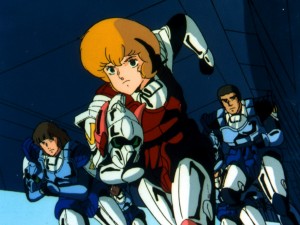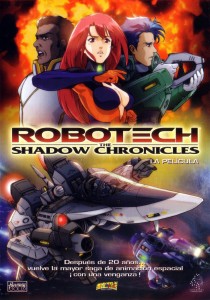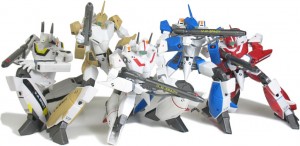Robotech: A Retrospective by Jerry Whitworth
One of the most popular animated series from the 1980s in the United States (beloved by many even today), Robotech told three stories of Earth as it entered into conflict with three separate alien invaders. Unlike much of the animation of the time in the country, the series didn’t shy away from the reality of its characters, with unique voices as they went through the series interacting with each other in bonds of friendship, love, and tragedy, to the realities of war and the hard decisions and losses those decisions bring. Robotech was also an early anime series brought to the States as well, though unlike predecessors like Astro Boy, Speed Racer, Gigantor, Star Blazers, and Battle of the Planets which were edited versions of their original programming, Robotech was spliced together from three separate series in Japan (a similar situation done earlier to much success with Voltron: Defender of the Universe which combined Beast King Golion and Armored Fleet Dairugger XV, with only the former catching on with viewers).
The Super Dimension Fortress Macross was a series that very much almost didn’t happen. Created by Studio Nue as a series to capitalize on the success of Mobile Suit Gundam, Macross was sponsored by the Wiz Corporation until differences of opinion between Nue and Wiz resulted in the series becoming delayed and eventually the Wiz went under selling the show and all of its rights to Nue. This led Nue to enter an agreement with advertiser Big West, who wanted to branch out into animation, to finish funding the series (though, despite their best efforts, the series continued to run over budget resulting in bringing in prominent studio Tatsunoko Production to finally bring the show to the finish line). The three-way agreement between Nue, Big West, and Tatsunoko would eventually lead to a court battle over who controlled the franchise. The show premiered on television in Japan in 1982 despite being unfinished but proved to be a remarkable hit with viewers leading to more episodes to be ordered (originally, Macross was suppose to be 48 episodes in length but was trimmed to 27 and its success led to it ultimately becoming 36). To reach this mark, Nue was forced to hand out animation duties to other studios including Tatsunoko (under AnimeFriend and Star Pro), Artland, AIC, and Gainax (which fans noted led to inconsistencies in the show’s quality). In all, Macross proved to be a remarkable success, becoming a series almost as beloved as Gundam (versions of Macross persist today as various sequels through film, original video animation, and television series continue to be produced, as with Gundam). The success of Macross led Big West to produce what is today referred as the Super Dimension Trilogy, three series independent of each other though each carrying the Super Dimension name where Macross was followed by Super Dimension Century Orguss and Super Dimension Cavalry Southern Cross.
In 1984, Macross was licensed to Harmony Gold USA to distribute the series in America. Originally, this was via the video tape market however Harmony Gold secured the rights to adapt the show for television through a deal with toy company Revell who would produce models for the series. Going to television as a weekday program, the series was too brief to meet requirements for syndication (where most companies make their money rebroadcasting a series repeatedly in reruns). So, to bolster its numbers, the unrelated series Super Dimension Cavalry Southern Cross and Genesis Climber MOSPEADA were incorporated into the series (something similar would be done by Harmony Gold for Captain Harlock and the Queen of a Thousand Years that same year combining Space Pirate Captain Harlock and Queen Millennia). Southern Cross was, as already noted, part of Big West’s Super Dimension Trilogy, animated by Tatsunoko and sister company Studio Ammonite. Also as noted, Super Dimension Century Orguss (developed by Studio Nue and animated by Nue, Artland, and TMS: Tokyo Movie Shinsha) was the second series in the Super Dimension Trilogy, but its story was inconsistent with the other series: Macross and Southern Cross were about the Earth being invaded where Orguss was about a fighter pilot being transported to an alien world. So, in place of Orguss, Artmic and Tatsunoko’s MOSPEADA series was used instead. Spearheading the adaptation project was Carl Macek, today a controversial figure who would become responsible for bringing a lot of anime to the United States in a burgeoning market, first as part of Harmony Gold and later through his Streamline Pictures, but who many fans believed unnecessarily edited programs to either abide by American standards or to better market series towards children. Macek transformed the three unrelated programs provided him into Robotech, an 85-episode series that premiered on American television in 1985 and would largely become regarded as the father of Robotech (involved from its conception to some of its most recent development).
As we know, Robotech was a huge hit. Not only was the show appealing to children, who got to see transforming vehicles battle giant aliens and various outer space mecha, but that carried a love story for young adults and a real heart and narrative that appealed to adults. In many ways, Robotech defied norms in America for animation in that it went beyond “kid stuff” and instead stood on its own as a work of drama without the pretenses long held in the animation community (then and even today) that someone of any age could enjoy. The three parts of Robotech made from the different series were broken up into the Macross Saga, the Masters (Southern Cross), and the New Generation. Macross told of an alien vessel coming to Earth, forcing the planet’s people to abandon their petty conflicts and form the Robotech Defense Force, a military agency composed of the world’s various armed forces to reverse engineer the craft, design weapons and vehicles from these advances, repair and deploy the fallen starship, and act as the world’s defense against alien conflict. This series of events proved quite fateful as the maiden test flight of the repaired craft, now dubbed the SDF-1, was greeted with an alien force seeking it. Referred as the Zentraedi, a bio-engineered race of gigantic warriors enslaved by the so-called Robotech Masters, this force was dispatched to retrieve the vessel. It’s revealed the SDF-1 once belonged to a Robotech Master named Zor, a man who seduced the queen of the Invid alien empire and stole the secrets of Protoculture (and the Protoculture Matrix, which produces it), a source of great power employed as fuel for the Invid’s technology (in turn, their way of life). It was this Protoculture which permitted the alien race that was the Robotech Masters to thrive likewise. The Invid hunted Zor, eventually killing him but not before he could program his ship to crash on Earth. And so, the Zentraedi arrived to take back the Matrix that powers the craft only to discover Earth used it to develop its own technology. Eventually, the Zentraedi realized allying with Earth, they would no longer have to be slaves and so abandoned their masters (those that did not would eventually perish battling Earth and their fellow Zentraedi). The Masters Saga followed the arrival of the Robotech Masters to Earth and the New Generation of the Invid invasion.
Just as with anything successful, plans soon came up to capitalize on it. Toy company Matchbox was awarded a license to produce a series of action figures, vehicles, and other merchandise on the series. Revell would try to release a second series of original models called Robotech Defenders based a a comic book series developed by DC Comics however, by the time this was realized, their contract expired and DC was forced to promptly cancel the series else face legal action by Harmony Gold. This didn’t hurt the companies’ relationship with each other as Robotech comics would be produced by Comico, Eternity, and various other publishers before ending up at WildStorm (an imprint for DC). An earlier toy for Macross ended up in America through Hasbro’s the Transformers line repainted as the figure Jetfire before legal action by Bandai (who supplied Matchbox the molds for the Robotech toys and was a major competitor of Takara, the company who initially designed most of the figures used by Hasbro) forced Hasbro to discontinue the toy (which would be re-engineered into Skyfire). The figure was a VF-1S Super Valkyrie Fighter from Takatoku Toys. In addition to various other media such as novels and role-playing guides and modules from Palladium Books, more animated features were in the works. A feature film was in development, using footage from AIC’s Megazone 23: Part One (co-produced with Tatsunoko) and Southern Cross but it bombed with test audiences and was scrapped. This film was intended to take place after events of the Masters. A sequel, of sorts, television series was in the works called Robotech II: The Sentinels.
Taking place between the events of the Macross Saga and the Masters, the Sentinels tells the story of the SDF-1’s surviving crew members and the Zentraedi (miniaturized to the size of humans) going into space aboard the SDF-3 to intercept the Robotech Masters before they reach Earth. However, this expedition force was unprepared as they instead uncovered the Invid and the various worlds they conquered (in turn, the SDF-3’s crew becoming pawns of the Invid’s mortal enemy the Haydonites). A few members of the SDF-3 would make their way back to Earth (such as Dana Sterling, the main protagonist of the Masters) but the ship itself wouldn’t arrive back at Earth in time of the end of New Generation (though part of its forces would assist in the final battle). However, where Macross was a series that nearly didn’t happen in Japan, the Sentinels became a series that never actually happened in America. Producing the show was a no-brainer, Robotech was a hit so Harmony Gold sought Matchbox to back a sequel and Tatsunoko Production was hired to helm the project. Carl Macek and his team wrote the series bible and sent drafts to Japan to be turned into new episodes. However, early on issues arose. Upon getting episodes from Japan, the series was being virtually re-written from what Macek submitted. Where Sentinels was suppose to explore a new group of heroes to emerge amongst a backdrop of returning characters, the episodes coming in starred the heroes from Macross. It was discovered because of how beloved Macross was in Japan, the writers therein re-wrote the plots to instead focus on the original Macross characters. After many back and forth arguments, episodes had to be reanimated forcing the project to be severely delayed. It was in part these delays that killed the project when the exchange rate of the dollar/yen crashed and forced Matchbox to pull out when the price for completion skyrocketed. However, a chunk of the 65 episodes ordered had already been animated leaving hope of releasing what was already done on video. Unfortunately, the warehouse that housed the completed animation burned down, taking with it this footage. Only the first three episodes survived, which were copied and was not at the facility. These episodes were cut into a film and were released on video tape through Palladium. Macek would go on to find Streamline Pictures which brought many anime titles to the US video market like Megazone 23, Casshan: Robot Hunter, Crying Freeman, Vampire Hunter D, 3 x 3 Eyes, The Professional: Golgo 13, Lupin the Third: The Castle of Cagliostro, Nadia: The Secret of Blue Water, Fist of the North Star, Robot Carnival, Lensman, Dragon Ball, Laputa: Castle in the Sky, Akira, My Neighbor Totoro, and re-released Robotech II: The Sentinels.
Interest in Robotech refused to subside. A line of toys for Robotech were released as part of the series ExoSquad. Carl Macek helped develop a CG-animated series called Robotech 3000 taking place in the show’s future and a trailer was produced from what was animated thus far aired at FanimeCon in 2000. Reaction was negative, which mirrored reaction by those within the company, and along with fiscal issues animator Netter Digital was having, the project was abandoned. In 2006, a feature film aired at select theaters and released for home video by FUNimation Entertainment called Robotech: The Shadow Chronicles premiered. Taking place at the finale of New Generation, forces made up of the expedition force and the worlds they liberated from the Sentinels arrive at Earth employing arms given to them by the Haydonites to retake Earth (the Invid, in fact, fleeing the Haydonites who they called the Children of the Shadow). Their victory is shortlived as the Haydonites attack, who made the weapons they supplied the forces ineffective as they try to wipe out all worlds that employ Protoculture (which they fear for unspecified reasons). When the Robotech forces realize the ruse, they employ older mecha that wasn’t upgraded to beat them back before detonating explosives to destroy the attacking enemy fleet. The forces split up as the Earth is reinforced with soldiers and Ark Angel, a vessel without any Haydonite technology, hunts down the SDF-3 which the enemy forces seek to destroy its inherited Protoculture Matrix. Carl Macek acted as a consultant on the film prior to his passing. While reaction was mixed, a sequel was shortly afterward in development called Robotech: Shadow Rising but the film went into limbo as a live action adaptation of the Macross Saga was optioned by Warner Bros and produced by Tobey Maguire (reportedly with the actor eying the main role as Rick Hunter) only to since languish itself. As of 2009, the live action film was under its fourth writing team to revise it. It’s likely the failure of Warner Bros’ Speed Racer film has left the studio hesitant to pursue Robotech as a live action film.
The future of Robotech is uncertain. Fans were hopeful the franchise was back on track with the Shadow series of films but that appears to be done. The live action adaptation left fans anxious as American companies historically have poorly handled like adaptations of anime but that seems to also be thoroughly exhausted. Video games continue to be produced, with Macross content not uncommon in Japanese games (such as the Another Century’s Episode series and, most recently, Macross Trial Frontier) as Robotech titles make their way in the US market (most recently with Robotech: The New Generation). There is, of course, always hope. Last year a new series of Voltron premiered on Nicktoons in Voltron Force. The anime market in the United States has dwindled in recent years, but Cartoon Network has in a fashion resurrected their Toonami block of programming (which at one time aired Robotech). Maybe someday fans will hear Lynn Minmay sing “My Time to be a Star” or “We Will Win” against the backdrop of an outer space battle between Earth and alien invaders again in either a reboot or entirely new show. One thing that can be said of Robotech fans is their patience: they waited almost twenty years for a sequel to the Sentinels and Shadow Chronicles showed there’s still enough interest to produce new content. Though, of course, without Carl Macek it’s like the Muppets without Jim Henson or Mickey Mouse without Walt Disney so any new venture will have to find its legs as, at least in part, a new entity (though creator Tommy Yune, who directed Shadow Chronicles, seems to have at least became a spiritual successor). Still, if the continued sale of Robotech merchandise in the United States is any indication, its fans will continue to exercise patience and wait for the return of Robotech.










http://www.robotech.com/news/viewarticle.php?id=473